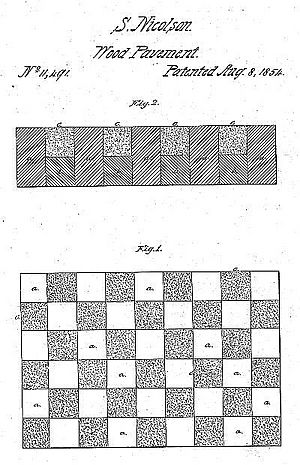City of Elizabeth v. American Nicholson Pavement Co. facts for kids
Quick facts for kids City of Elizabeth v. American Nicholson Pavement Co. |
|
|---|---|

|
|
| Argued October, 1877 Decided May 13, 1878 |
|
| Full case name | City of Elizabeth v. American Nicholson Pavement Company |
| Citations | 97 U.S. 126 (more)
24 L. Ed. 1000; 1877 U.S. LEXIS 1761; 7 Otto 126
|
| Prior history | Appeal from the Circuit Court of the United States for the District of New Jersey |
| Holding | |
| Public use of an invention for the purpose of testing and experimenting with it does not create a bar to patentability. | |
| Court membership | |
| Case opinions | |
| Majority | Bradley, joined by unanimous |
| Laws applied | |
| 35 U.S.C. § 102 | |
City of Elizabeth v. American Nicholson Pavement Co. was an important case decided by the Supreme Court of the United States in 1878. The case was about whether an inventor could lose their right to a patent if they used their invention in public before applying for the patent.
The Court decided that if an inventor uses their invention in public to test it, they do not lose their right to get a patent. This is an exception to the general rule that public use before applying for a patent can stop an inventor from getting one.
What Happened in the Case?
The story begins with an inventor named Samuel Nicholson. He created a special way to build pavement using wooden blocks. He got a patent for his invention on August 8, 1854. A patent is like an official document that gives an inventor the sole right to make, use, or sell their invention for a certain time.
After Nicholson passed away, a company called American Nicholson Pavement Company took over his patent rights. They sued the City of Elizabeth, New Jersey, and two other companies. The lawsuit claimed that these groups were using Nicholson's special pavement without permission. This is called patent infringement.
The defendants, including the City of Elizabeth, argued that Nicholson's patent was not valid. They said his invention was not new enough. They also claimed that Nicholson had used his pavement publicly for six years before getting his patent. They believed this public use meant he had given up his right to a patent. This rule is known as the "On-sale bar" in patent law.
A lower court first heard the case and decided in favor of Nicholson's company. The defendants then appealed, meaning they asked a higher court to review the decision.
The Supreme Court's Decision
Justice Bradley wrote the main opinion for the Supreme Court. He first looked at other similar inventions that already existed. This is called "prior art". He found that nothing in the prior art showed that Nicholson's invention was not new. Even though some parts of Nicholson's pavement might have been known, his specific way of combining them was new.
Next, Justice Bradley looked at whether Nicholson had lost his patent rights because of his public use. He carefully examined how Nicholson used his invention in public.
In 1848, Nicholson had put down a section of his new pavement on a turnpike (a type of road where you pay a fee to use it) in Boston, Massachusetts. He did this to test how strong the pavement was and how people would react to it. Nicholson was also part of the company that ran the turnpike.
Justice Bradley explained that Nicholson's actions did not show he wanted to give up his patent rights. Nicholson had no other way to test the pavement's strength and durability except by letting the public use it. He also watched the experiment closely. He did not sell his invention or let anyone else use it widely.
Even though people using the turnpike got some benefit from the new pavement, Nicholson did not give permission for anyone else to use his invention freely. He applied for his patent as soon as he was sure his pavement system worked well. Justice Bradley said that this type of public use, which was for testing and experimenting, did not stop Nicholson from getting his patent.
The Court agreed with the lower court that the defendants had copied Nicholson's patented pavement without permission. The City of Elizabeth did not make money from it, but the other two companies did. Their responsibility to pay for the infringement was not changed by Nicholson later giving his patent rights to someone else.


